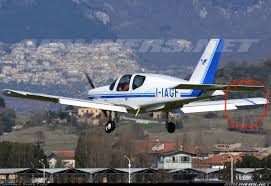Not easy to find a suitable picture, hope this is adequate. I believe on the Cessna there is a point on the wing strut used for the same purpose. On low wing aircraft its usually located roughly 1/3 wingspan from the wingtip.

The wing striping is used to indicate the correct downwind distance during a normal traffic circuit, when keeping the stripe on the runway and turning base when the threshold is 45 degrees behind the wingtip you have a sufficiently long base and final leg. Using this technique, when flying the circuit higher above ground you will automatically be flying downwind further out.
Off topic, instead of turning base when threshold is 45 degrees behind the wingtip, you could time height above ground / 100 x 3 (e.g. 1000 ft AGL = 30 seconds). And then correct timing for head or tailwind, thats the instrument way of performing a visual approach or circling approach.
During engine failure the strip roughly indicates the aircraft glide range in zero wind, you can draw an imaginary circle between the stripes on each wing and everything within that circle should be within glide range.
On downwind with an engine failure, keeping the stripe on the intended landing area indicates correct downwind distance, since you are gliding this means you need to fly downwind slightly converging to keep the stripe on the landing area.
This is all not an exact science of course as it is influenced by the pilots “eye-height”, it depends on your height, seating position, and sitting in the left or right seat. Furthermore the glide range is influenced by wind of course. Generally its a nice indication though.
There are a lot of rules of thumb or “keys” like that in aviation to make your life easier. To give some more examples of rules of thumb I use on a daily basis in the real world:
-
Top of Descent planning is altitude to lose / 1000 x 3 or FL / 10 x 3 (e.g. 10.000 ft = 30 nm).
-
Reducing speed on approach for a jet is 1 nm per 10 kts in level flight or 2 nm per 10 kts in a 1000 ft/min descent, (cut in half using speedbrakes).
-
Turboprops can easily lose their speed while maintaining a 3 degree glidepath, height at which to start reducing speed = speed x 10 (e.g. 250 kts = 2500 ft AGL), this will ensure you are stable at 500 ft AGL, in IMC add 500 ft to be stable at 1000 ft AGL.
All not an exact science again, it all depends on the aircraft type, weight of the aircraft and wind but its a nice approximation to give some rough idea. You then just add or subtract a couple miles depending on weight and wind. And you know at some point which aircraft are more “slippery” than others. Its a nice general technique.